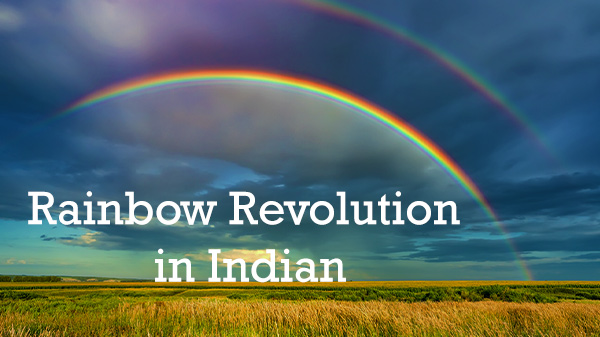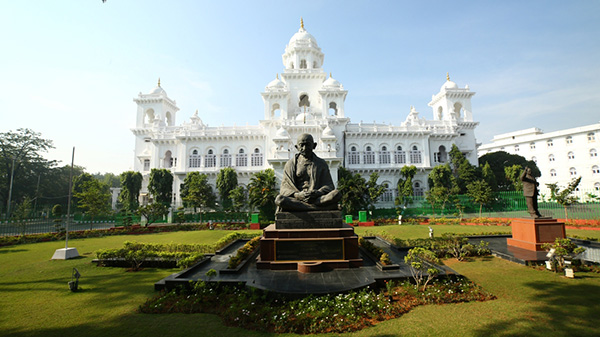Rainbow Revolution in Indian Agriculture through innovative Agri Extension

Earlier today, I chaired a session on “Agri Business Extension” at the NAARM – IFPRI Workshop on “Redesigning Agricultural Extension in India”. Since that was the last technical session of the Workshop, I had an opportunity to include “my take-aways” from the deliberations in all the four previous sessions in my opening remarks. My closing remarks were based on the presentations made in that session and the discussions that followed.
My Opening Remarks:
After the Green Revolution for Grains, White for Milk, Yellow for Oilseeds and Blue for Aquaculture, the phrase ‘Rainbow Revolution’ has been used in Indian agriculture to describe the growth of the horticulture sector. Today I would like to use that label to signify the revolution we can bring about through innovative agri extension services. For a reason… At the beginning of this workshop, we had a white canvas on which we could paint the future of agri extension. While reflecting on the deliberations of the earlier sessions in my own mind, I visualised seven distinct colours on such a painting, if we were to achieve the revolution we all want. Hence my choice of expression, “Rainbow Revolution”!
The first colour I visualised suggested that our focus must be on the farmer. Not just as a passive recipient of Knowledge, as in the traditional paradigm of ‘Last Mile in the Technology Transfer”, but as an active Co-creator of Knowledge in a multi-way knowledge exchange paradigm. This would ensure access to personalised solutions to the farmer, besides setting a reality oriented agenda for agri research itself…
The second colour depicted synchronised delivery of information, knowledge and inputs. This takes us beyond just transfer of knowledge to actually applying it on the ground. Inputs here mean credit, seeds, nutrients, crop protection chemicals, access to farm equipment, risk management solutions etc.
The third colour called for an alignment with the Government’s flagship agriculture programme RKVY, to be able to create a force multiplier. This in turn means building the capacity for village and district level planning. At the same time, there is also a need for redesigning Government programmes to ensure that they don’t unduly distort markets; because at the end of the day, we are relying on a market economy.
The fourth colour sought integration of agri extension into the full value chain of that produce. This approach will figure a way to create value by serving the changing needs of an evolving consumer. This also will consciously extend the role of agri extension into the vital post-harvest arena.
The fifth colour I had visualised demanded accountability of the system to all its stakeholders. An outcome oriented system instead of input or output as the only metrics. Today, by making the extension service free, we may have taken away the farmers’ right to demand quality. Even a token payment will work wonders in ensuring accountability!
The sixth colour appealed that we be sensitive to the non-renewable natural resources. Agri Extension must promote Conservation Agriculture as much as possible. All of us know the three dimensions of agriculture vis-à-vis climate change (1) that agriculture is a part of the problem, causing climate change through Green House Gas emissions (methane from flooded paddy fields & ruminants like cows, nitrous oxide from the soils, CO2 from fossil fuels used in farm equipment etc), (2) that agriculture is also one of the most vulnerable sectors impacted by climate change (fall in productivity due to changing weather patterns), and (3) that agriculture can be an important part of the solution to climate change (through emission reductions, carbon sequestration, increasing soil organic matter etc)
Finally, the seventh colour stressed the need for a proactive agenda on gender issues in agri extension. Analyse gender roles in farming systems, enable gender sensitive agri extension methodologies…
To paint these seven colours, the speakers in this session have access to several new brushes.
For example, the leapfrogging developments in communication media, information processing and presentation. The medium must be relevant to the message and the context.
Power of partnerships is another good brush! Define complementary roles, varied resources of different partners, and the shared aspirations. Deal with the challenge of mistrust, as one of the earlier speakers pointed out.
Co-opting social capital resident in the communities for relationship building and group mobilisation.
Then, there are several innovations in aggregation methods, business models and conflict resolution approaches.
Our artistes, the business people that they are, have certain unique capabilities.
Consumer centrality is the essence of business. Understanding, designing and delivering consumer-relevant solutions is how businesses thrive.
These businesses are accountable through “choices”. Consumers simply vote with their wallets and feet, when they have choices. Businesses become unsustainable if their solutions are redundant.
Governance processes and the management capacity of businesses need not be reminded to this audience.
Before I pass the floor on to our first speaker, let me also share the specific brush strokes I want to see from each of these artistes…
What’s the role of agri-business in extension? What are the risks of businesses engaging in extension activity? What are the contours of a new regulation that can mitigate such risks?
Should the role of Government be restricted only to those areas businesses won’t go? That is, poor farmers, backward regions, long term challenges, subsistence crops etc. How do we ensure that subsidies do not unduly distort the evolving agri services market?
My Closing Remarks:
So, we now have a colourful painting and a beautiful frame.
The painting portrays a “co-creation platform”, if I can call it so. The platform provider could be Government, or a Co-operative or an Agri-Business. The platform operates globally, but enables seam-less local participation of multiple stakeholders who can simply plug & play. Such an orchestrated yet open platform has the ability to produce a rainbow at will…
The frame I see has the character of regulating by fostering competition, rather than by restricting. The subsidies are delivered through coupons, so farmers can exercise choice across multiple platforms!










